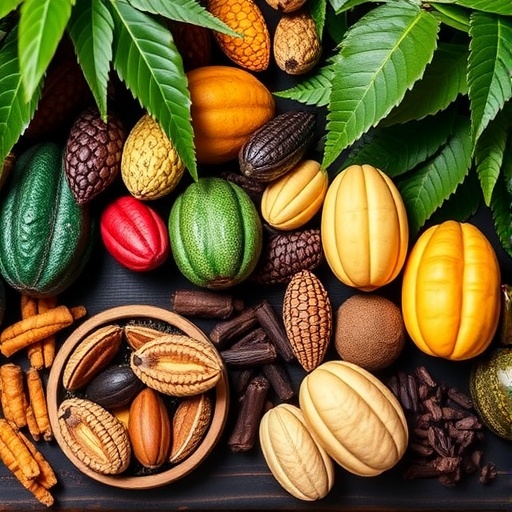In a groundbreaking study spearheaded by Todd et al., researchers are addressing the critical need for the conservation and management of Theobroma cacao, the species responsible for producing cocoa used in chocolate. The study emerges against a backdrop of escalating threats to biodiversity and the sustainability of agricultural practices. The conservation of genetic diversity within T. cacao is imperative, not only for the health of the species itself but also for the livelihoods of millions of farmers globally who depend on cocoa cultivation.
Cocoa trees, native to the humid tropical regions of Central and South America, have faced significant pressures from climate change, diseases, and pests. These challenges have threatened the survival of various cacao strains that possess unique traits vital for adaptation. In response, the research team embarked on a meticulous project aimed at developing a core collection of cacao genetic material, ensuring the preservation of diverse genetic traits that can withstand these adversities.
One of the primary motivations behind this research is the alarming rate at which genetic diversity among cacao varieties is diminishing as traditional farming practices are replaced by monoculture. This approach, while initially more profitable, leaves cocoa crops vulnerable to diseases and pests, which can spread rapidly when all plants share similar genetic makeup. By establishing a core collection, the researchers aim to safeguard a repository of genetic diversity that can be accessed for breeding programs and future agricultural practices.
The study utilized advanced genomic techniques to analyze genetic traits across a vast array of cacao samples. These techniques allowed the researchers to identify key genetic markers associated with resilience to disease and climate adaptability. Interestingly, the findings indicated that certain underutilized varieties exhibited traits that could contribute to more resilient cocoa crops, yet these varieties are often overlooked in current agricultural practices.
Furthermore, the research delves into the historical context of cacao cultivation and the traditional methods employed by indigenous communities. It highlights how cultural practices have historically contributed to the conservation of genetic diversity, maintaining a balance between agricultural needs and ecological sustainability. The researchers advocate for integrating traditional knowledge with modern scientific approaches to enrich the conservation strategies for T. cacao.
As part of their methodology, the team established a comprehensive database that categorizes and indexes cacao genetic resources. This database serves not merely as a catalog but as an interactive platform for researchers, breeders, and agriculturalists. It facilitates access to genetic material, thereby accelerating the selection process for breeding initiatives aimed at enhancing disease resistance and climate resilience among cacao plants.
Through this innovative research endeavor, Todd et al. highlight the vital connection between biodiversity conservation and agricultural sustainability. By preserving genetic diversity, the study emphasizes the potential to cultivate crops that can better adapt to changing environmental conditions, ultimately leading to more sustainable production systems. This is particularly relevant in the context of increasing global cocoa demand, which places additional strain on already fragile ecosystems.
The authors of the study underscore the importance of collaboration among various stakeholders, including agricultural researchers, government bodies, and farmers, to implement effective conservation strategies. They argue that fostering a multi-disciplinary approach could enhance the resilience of cocoa farming systems and promote the long-term sustainability of cacao production.
In their conclusion, the research team calls for urgent action to prioritize the conservation of Theobroma cacao genetic diversity. They stress that failure to do so could jeopardize the future of cocoa cultivation and threaten the livelihoods of millions of farmers worldwide. Moreover, the implications of this research extend beyond cacao; they serve as a model for conservation efforts aimed at other economically significant crops facing similar challenges.
The implications of this study are profound, not only for the cacao industry but for global food security. As the impacts of climate change become increasingly apparent, the need for resilient agricultural crops has never been more urgent. This research sets a precedent for future studies aimed at conserving genetic diversity in other vital crops, ultimately contributing to a more sustainable agricultural future.
Researchers, policymakers, and agricultural practitioners are encouraged to take heed of these findings and integrate them into their practices. The collaboration of various sectors can further enhance the resilience of global food systems, ensuring that future generations can thrive in a changing world.
As the awareness of the importance of genetic diversity in agriculture grows, this study will likely resonate with a broad audience. It presents a compelling narrative that interweaves science, culture, and sustainability, emphasizing the interconnectedness of our ecosystems and agricultural practices. Such research not only highlights the urgency of conservation but also inspires a collective movement toward sustainable agricultural practices.
To truly harness the potential of Theobroma cacao, continued research and investment in conservation initiatives will be vital. The findings of Todd et al. serve as both a warning and a call to action, reminding us of the responsibilities we hold in preserving the delicate balance of our agricultural biodiversity for future generations.
Subject of Research: Conservation of Theobroma cacao’s genetic diversity
Article Title: Developing a core collection for the conservation of Theobroma cacao’s genetic diversity.
Article References:
Todd, E.T., Arigoni, F., Holzwarth, J. et al. Developing a core collection for the conservation of Theobroma cacao’s genetic diversity.
BMC Genomics 26, 896 (2025). https://doi.org/10.1186/s12864-025-11882-6
Image Credits: AI Generated
DOI: 10.1186/s12864-025-11882-6
Keywords: Theobroma cacao, genetic diversity, conservation, sustainability, agriculture, climate resilience.
Tags: agricultural practices and biodiversitycacao genetic diversity conservationcacao strain adaptationclimate change effects on cacaococoa biodiversity preservationcocoa cultivation livelihoodscocoa production and environmental healthgenetic material core collectionmonoculture farming challengespreserving cacao genetic traitsTheobroma cacao sustainabilitythreats to cacao biodiversity





